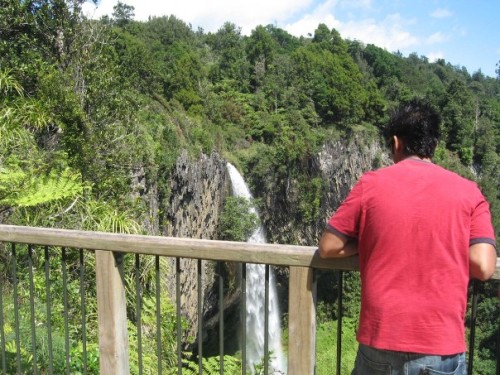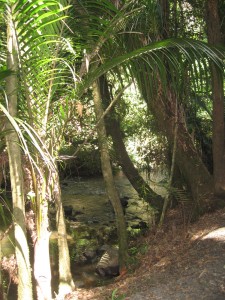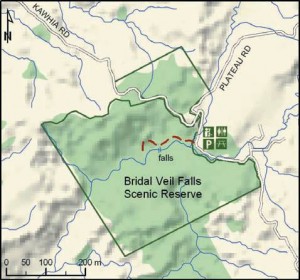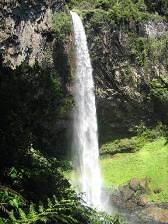
The Bridal Veil/ Waireinga Falls are located 5km East of Te Mata. Coming from Raglan on SH 23 turn right into the Te Mata Road. (Coming from Hamilton or Whatawhata turn left off SH 23 a few minutes past Te Uku.) Continue through the Te Mata village and follow the signs to the car park outside the entrance to the reserve. Waireinga means leaping waters, referring to wairua (spirits) leaping the great height of this waterfall. Waireinga is also spiritually known by tangata whenua (people of the land) to be occupied by Patupaiarehe (Maori fairies) who are kaitiaki (guardians) of the area.

The reserve is maintained by the Department of Conservation who completed a major upgrade of tracks and steps in 2011. There are public toilets just inside the entrance to the reserve. A little further on there is a picnic table. It is an easy walk to the top of the Bridal Veil/Waireinga Falls following the Pakoka River for most of the way. The track is through a native forest canopy and is suitable for pushchairs and wheelchairs to the two viewing platforms at the top. The walk from the carpark to the top of the falls takes about 10 minutes each way. The water flowing in the Patoka River has journeyed a long way from its headwaters in the forests on Pirongia. It is the home to eels (tuna), freshwater crayfish (koura), freshwater mussels (kakahi) cran’s and red fin bullies, banded kokopu and common smelt.

There are steep steps down to the pool at the base of the falls (Note: water quality in pool is not healthy for swimming). 135 steps will take you to midway viewing platform, but to get to the bottom of the falls you will be going down 261 of them in total.

The rocks around the pool are mainly soft sandstones that have been worn down by the river to form a large amphitheatre. If you look up at the cliff face you can see the band of hard basalt rock that has resisted the erosive power of the river and now forms the lip of the spectacular 55-metre falls. It seems like human construction, but the regular columns are a freak of nature known as columnar basalt. basalt. This rock formation was created some two and a half million years ago when molten lava from a volcanic eruption flowed down a river course, pooling in a valley. As the lava slowed, the top and bottom started to cool and shrink. Cracks and joints appeared, running
directly down from the surface of the flow. Because the hotter and semi-liquid part of the lava was still moving the joints developed a distinctive curve.
Around the pool there are many nikau palms that thrive in the micro climate.

Thanks for the link in your article on areas to visit.